| Cover
Story
When Buildings Fall Apart
Shamim Ahsan
Photo: ANISUR RAHMAN

QAZI Harunur Rashid was chatting on a laptop from his office with his friend Zahid, both computer engineers and graduates of AIUB. "At around 11 am suddenly there was no response from Harun's side. I thought he went somewhere to attend some work. I also went back to my work. After some two hours or so I got to know that Harun's office building collapsed. I was shocked and numbed with panic. I did not know what to make of it," Zahid says in one breath. Zahid then rushed out of his Jubak Phone office and reached the collapsed building. Standing in the street right in front of the heap of debris that remained of the five story building, Zahid rubs off the sweat from his forehead.
Harun's elder brother Mamun is running up and down the disaster site. He once again comes to the place where the building's security personnel are guarding the recovered materials -- a computer monitor, a key board, half a dozen box files, pens, and a scale -- retrieved from remnants of the fallen building. Once more Mamun asks the direction of the room where his younger brother used to sit. The first floor is now a pile of rubble made up of broken parts of columns and bricks.
At around 12, after learning about the accident, Mamun called at his cell phone. The phone was turned on and Mamun heard an unknown voice saying to another "how does one get the SIM out?" and then "What do you think, is the man alive or dead?" "I was shouting at the top of my voice "Bhai, please see what is the condition of my brother? Please, just tell me how he is?" But those unknown voices were not listening to him, Mamun says.
"Harun had joined the hospital as a network engineer just a week ago," says Qazi Mamun as tears roll down his cheeks. Harun's dead body was later recovered at 6 pm on Saturday on the very day the building collapsed. He was only 26.
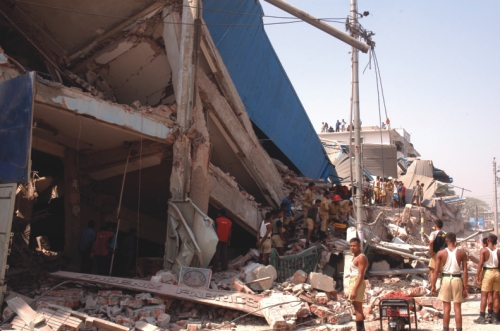
A view of the Phoenix building that collapsed on February 25, eight bodies were retrieved on the first day; death toll rose to 20 on the third day
The collapse site has eerie resemblance to the nine-storied Spectrum Garments building in Savar that collapsed into a pile of rubble on April 11 last year killing 62 people and injuring scores of others. The four storied building in Mohakhali has reduced to half of its original height, as the columns gave away, roofs have come frighteningly close to each other, maintaining a distance of just four to five feet. Crumpled tins, entangled beams and columns and a huge heap of broken and half-broken bricks in between them are all jumbled up over a vast area of 4 bighas. At around four pm, on Saturday, Selim Newaj Bhuiyan, Deputy Director of Fire Brigade announces that they have so far recovered 11 dead bodies and four wounded persons. As Bhuiyan says, it would take a couple of hours more before his rescue members once again can enter into the fallen building. After the debris is cleared off to a certain point the Fire Brigade people will cut a hole into the top floor and then can hope to rescue the trapped. How many people have been trapped under the rubble? Everyone has a different figure to tell, but most of them are in the corridor of 100. Looking at the huge mess of concrete it's really difficult to imagine the existence of life inside it.
General Nizam, in charge of the rescue operation, is not about to give up. A revolving excavator is tearing apart mangled tin, brick pieces from the surface of heap of debris. Another wheel-run excavator is clearing the rubbles of the front part while a huge crane is gearing up to start working on the main road. As Nizam gives direction waving his hand around a hundred army men advance in line, getting hold of a broken tin or a piece of beam, going back and throwing them in the vacant space on the left side of the building. And that's all that is happening. When several dozen people, who are still alive, are battling with death and when one second's difference can mean passing over from life to death, the pace of the rescue operation four hours into the collapse look excruciatingly slow.
Bhuiyan, however, shows the grill machines, gas cutters, pneumatic hammers, pickaxes, hammers that are gathered in one corner, which he says, will come into operation once a certain portion of the rooftop can be cleared off rubbles.
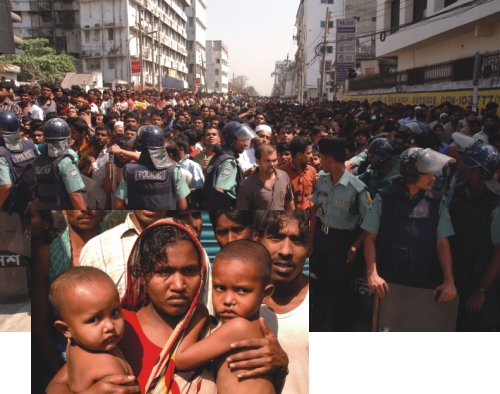
Eager to know the truth: relatives wait as the rescue effort progress in snail-pace
A large stretch of Tajuddin Road has been cordoned off by around a thousand fire brigade, army, police, Rapid Action Battalion (Rab) and Bangladesh Rifles (BDR) men. Beyond the restricted area stand several hundreds of curious people surrounding accident spot. But among those hundreds of curious faces, there are some anxious faces too those are of the family members, relatives, friends and acquaintances of those inside this small hill of rubble. Mozammel is one of them. He has talked to Mosharraf, one of his two brothers trapped in the collapsed building, over cell phone. "My brother is alive, please let me get in," Mozammel pleads, but on duty Rab man will not let him in the restricted area.
The doomed four-storied building at Tejgaon commercial area at plot no 313 housed a garment factory, called Phoenix Fabrics until a month ago. There were also showrooms of Phoenix Fabrics and Phoenix Electronics on the ground and first floors. Aged around 22-25 years the building was originally two storied and several years ago two additional floors were added. On the rooftop stood a number of tin-shed rooms.

Rab, Army and police personnel lend a hand in the rescue effort
After shifting the garment factory from here about a month back, the interior of the building was being restructured to turn it into a hospital. Many believe the renovation work may have caused the collapse. During the collapse it was mainly the construction workers, tiles and sanitary workers, masons and electricians as well as some officials and employees of the going-to-be hospital who fell victim to the disaster.
"I was plastering a room on the third floor when at first I heard the sound of an electric generator. Soon I heard the sound of crumbling and saw the walls of the northern part of the building collapsing," Minhaj Uddin, a mason, narrates the first few seconds of the collapse. Though he has survived with minor injuries in his head, legs and hands, his close brush with death has left him traumatised.
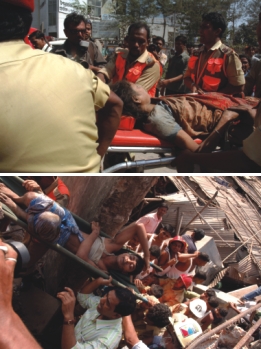 "Seeing the walls and pillars collapsing, we tried to run out of the building but did not get enough time," he says. "I saw the whole building tumbling down and a wall fell on me, pinning me to the ground." "Seeing the walls and pillars collapsing, we tried to run out of the building but did not get enough time," he says. "I saw the whole building tumbling down and a wall fell on me, pinning me to the ground."
As the building caved in, about three dozen corrugated tin-made shanties right behind the building, customers and salesmen of a couple of makeshift tea stalls raised along the building, and two rickshaws, a CNG-run three-wheeler and two empty microbuses parked on the roadside, were crushed. Eight dead bodies and some 20 wounded were recovered from these spots within the first hour of the accident. The casualty figures however continued to rise as time went by.
ACCORDING to Jamilur Reza Chowdhury, vice chancellor of BRAC University, the main reason for building collapse is either fully ignoring or not exactly following the building code. One guilty party is obviously the institutions entrusted with the task of approving the design and monitoring it to make sure a particular building being constructed in line with the approved design. In Dhaka's case it is RAJUK, that is not performing its duties properly.
There is a building code, says Chowdhury, which specifically spells out what must be done for different kinds of buildings. It also has specific directions regarding design. A particular
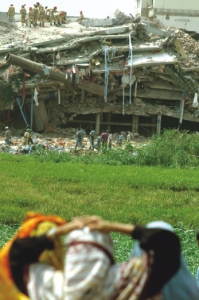
The collapse of the Phoenix building reminds one of the Savar tragedy in which 62 workers lost their lives. Unfortunately, no one was brought to the book |
building's column, slabs, beam have to be designed and built depending on the purpose for which the building will be used. "Buildings meant for residence", adds Chowdhury, "have much low load than those meant for a garment factory. Now if a residential building is used as factory it is bound to become vulnerable to accidents." Referring to the collapse of Spectrum Sweater Factory in Savar Chowdhury says that one of the columns of the factory building was faulty. Concrete did not reach some part of the column and it was from that weakness, the process of collapse really started. It was found out that there was a piece of throwaway/discarded cloth in the column.
"I cannot say exactly why the Phoenix building collapsed. That would require a full fledged examination of the building, its design, planning, construction materials etc. But looking at its present form (after the collapse of course) it seems the foundation of the building was weak. That's why it caved in," Chowdhury observes.
The building had a foundation for three storeys but the owners went for further vertical expansion and in the process imposed more load than the building's foundation could withstand, he explains.
Again more often than not these buildings are not designed by qualified structural engineers; the owner often goes ahead with the contractor alone or gets the design done by unqualified or less qualified engineers.
The use of sub-standard construction material can also lead to such disaster says Cowdhury.
Selim Newaj Bhuiyan, deputy director, Fire Service and Civil Defence, adds to the list of possible reasons for the collapse. "The building is on a busy street where heavy vehicles are always passing by. They might not have considered the highway vibration while constructing the building," Bhuiyan observes.
Echoing Chowdhry, Bhuiyan, also points to the load distribution factor of the building that might not have been proper, which could have been also a contributing factor to the collapse.
Construction of extra floors on top of a building with a foundation for three storeys and unplanned renovation works could be the reasons for the collapse of the factory building of Phoenix Fabrics.
KAM Haroon, chairman of Rajdhani Unnayan Kartripakkha (Rajuk) says as the building was built at least 25 years ago, Rajuk authorities back then did not permit the owners to build more than three storeys.
"We are yet to find out the file for that building. But I think it was not more than three storeys," Rajuk chairman told The Daily Star. "Unplanned renovation works might have quickened the collapse," he adds.
After every such disaster the various concerned departments' inefficiency, lack of trained manpower and inadequacy of modern equipment get exposed. Jamilur Reza Chowdhury says that early last year the government formed a committee that was tasked to suggest equipment for post earthquake emergency situations. Chowdhury who happens to be a member of the committee came up with a detailed list of essential equipment to face accidents of such big proportions. I don't know if those were bought. It seems they weren't," Chowdhury says.
The rescuers also admit that the equipment is not enough for the rescue work. Instruments like tower cranes would have come very handy to remove the debris quickly," Bhuiyan points out.
"We don't have the experience and equipment needed for such a massive operation," Bhuiyan adds.
If anything it shows the concerned authority's, and ultimately the government's, indifference regarding such serious matters. "We suggested bulldozers, field hospital and some other light equipment that are used in the developed countries. They are also not so expensive that the government cannot buy them. It is just that these do not seem to be on the government's priority list," Chowdhury opines.
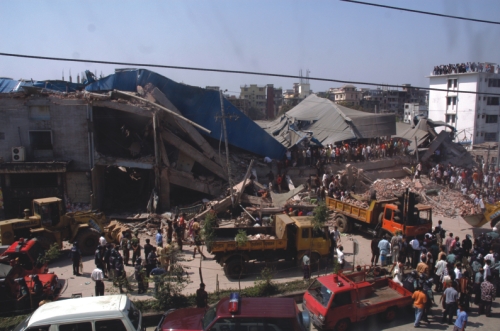
Death toll rose to 20 on the third day after the collapse, but 80 or so bodies are feared to have been lying underneath the rubles
Meanwhile, the BGMEA (Bangladesh Garment Manufacturers and Exporters Association) has decided to inspect all the garment factories across the country within the next one month to find out whether the units are following the necessary safety standards and other compliance issues set by the national and international organisations. The government, in a show of unprecedented alacrity, passed a law titled "Building Construction (Amendment) Act 2006" that carries stringent punishment for designing or approving or implementing a faulty construction. So far it only seems words on a piece of paper.
AS it always happens a great uproar has been raised over the building collapse. Ministers visiting the spots vow to put the offending owner and corrupt RAJUK officials on trial. The garment industry leaders have made new resolutions and issued threats against the owners who are not maintaining standard work environment. But nothing comes out of all the furore and things go on as before. The consecutive disasters in Chittagong (where a garment factory caught fire killing 54 people) and Dhaka only point out to the sheer callousness of the owners of these establishments and buildings, the government officials in charge of monitoring the buildings, towards safety standards and human life. Even more frightening is the fact that there are hundreds of buildings in Dhaka city and other cities that have been constructed with similarly faulty methods or poor quality materials. They are disasters waiting to happen.
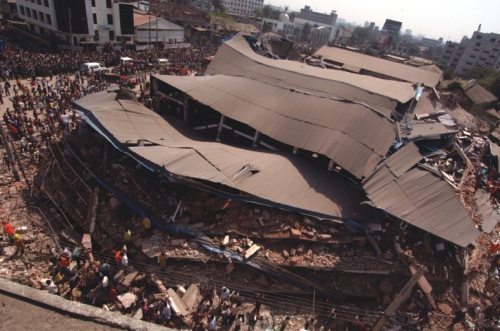
Dhaka is dotted with sloppily built structures and the sheer callousness of the authority in charge of monitoring buildings is also to be blamed for the situation
Most garment units lack safety measures
GOVERNMENT factory inspectors have recently visited 100 garment factories and found 48 of them operating without basic safety arrangements for their workers.
According to rules, garment factories must have such arrangements including alternative staircases to facilitate emergency exit of workers at the time of fire or any other accident.
As the office of the Chief Inspector of Factories (CIF) does not have adequate manpower, it selected the factories on a random basis out of around 4,000 garment units.
The CIF has only four staff that inspected the 100 factories in the last couple of months following a directive of the parliamentary standing committee on the labour ministry.
The CIF, a wing of the labour ministry, submitted its survey report on March 31 to the standing committee stating that factory workers were at serious risk of accidents.
The report states that due to lack of manpower the CIF cannot take legal action against all the factory owners who are violating the safety rules.
The factory owners have to face legal procedures if their factories do not have the mandatory safety arrangements, says The Factory Rule 1979.
According to available statistics, as many as 295 garment workers died and 2,510 were injured in 22 fire incidents in 15 years since 1990.
Copyright
(R) thedailystar.net 2006 |
